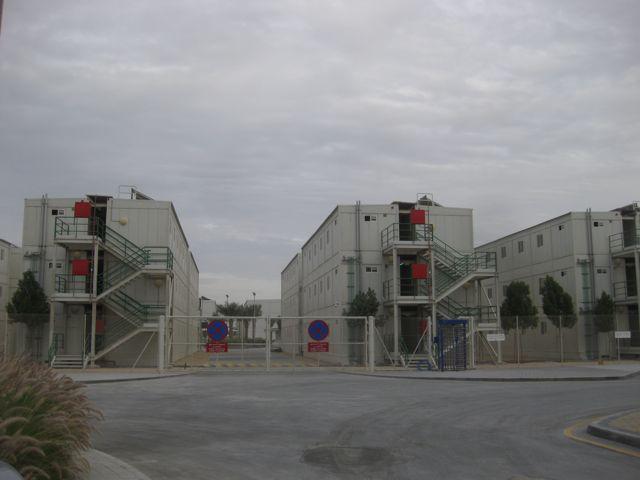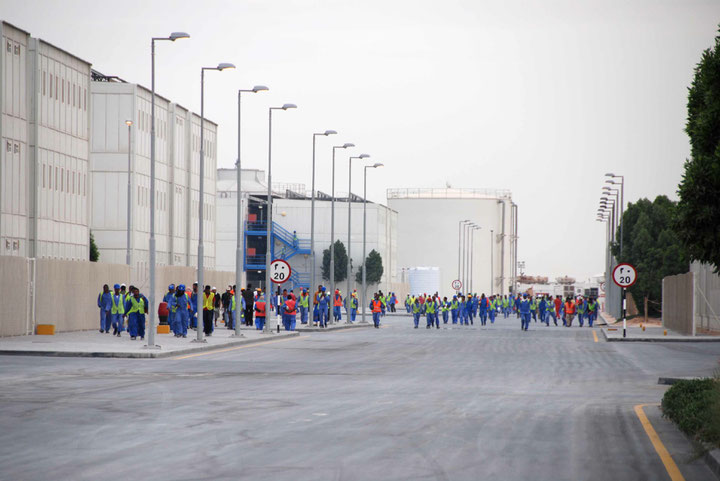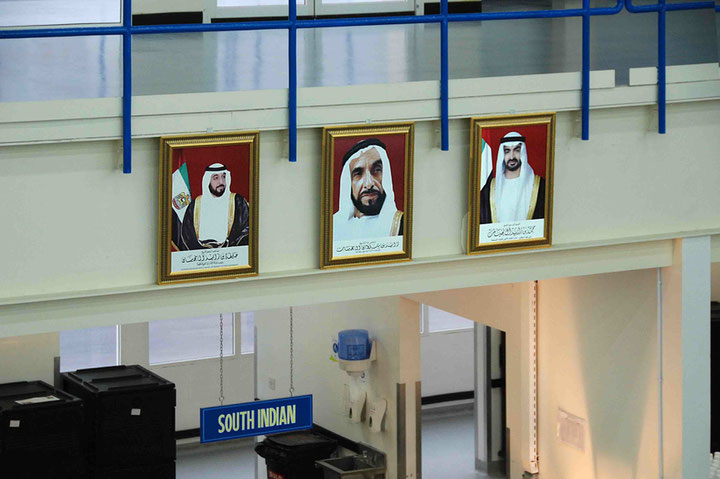Issue 1/2012 - Bon Travail
The Return of the Artist as Social Activist from the Abu Dhabi Guggenheim Boycott to the Occupy Wall Street Movement
»We are writing to let you know that the boycott of the Guggenheim Abu Dhabi remains in place,« asserts the latest communiqué of Gulflabor Coalition (GC), sparing neither words nor regrets. GC is an ad hoc, informal group of artists and labor activists who have been campaigning for human rights and fair labor practices in Abu Dhabi where a palatial Gehry–designed Guggenheim will one day tower over the arid sand dunes of Saadiyat Island. In full disclosure, I am a member of the group and have visited the site of this future project, also known as the Island of Happiness, which is just off the coast of Abu Dhabi in the United Arab Emirates (UAE). GC’s boycott campaign began eight months ago on March 16, a date timed to coincide with the opening of Art Dubai and the 10th Sharjah Biennial. The group’s first public statement put it this way: »artists should not be asked to exhibit their work in buildings built on the backs of exploited workers. Those working with bricks and mortar deserve the same kind of respect as those working with cameras and brushes.«
At stake is human rights, especially those of thousands of laborers brought to the UAE from Pakistan, Bangladesh, Malaysia and other, less developed nations by contractors who frequently charge steep access fees, confiscate passports to prevent departure by workers, and who respond to labor unrest with harsh retribution. Along with a similarly ambitious project with the Louver Museum, and New York University among other Western »brands,« Abu Dhabi and its Island of Happiness seek to transform today’s petrodollars into tomorrow’s cultural capital. Although in some ways reminiscent of modernist endeavors in the early Soviet Union or Brasília in the 1960s in which the avant–garde sought to inspire and transform the international working class through utopian art and architecture—the highly capitalized Saadiyat Island experiment makes absolutely no pretense that those who now construct this empire of cultural sophistication will ever be permitted entry after its completion.
Posted on iPetitions.com GC’s boycott swiftly garnered over a thousand signatures. The Guggenheim and its Abu Dhabi partner, the Tourism Development and Investment Company (TDIC) who manage Saadiyat Island’s development, responded immediately. In public statements both the museum and TDIC emphasized their respect for the rights of artists to protest, although neither the Guggenheim nor the development corporation offered to extend this same liberty to Abu Dhabi’s disenfranchised immigrant laborers or political dissidents. Nevertheless, since the boycott has been in place at least one of the more blatant abuses in the region has improved. The crushing fees charged by ruthless contractors have been promised to be repaid to workers. This was a key concern of a stinging report by Human Rights Watch (HRW), the premier social–justice NGO actively investigatingn abuses in the region. Less heartening is the half–measure made by TDIC to fulfill another crucial request made by both HRW and GC involving the hiring of a full–time independent labor monitor for the island. With some fanfare TDIC announced it had employed the auditing firm of PricewaterhouseCoopers (PwC) in this past June. So far so good because PwC is to be charged with reporting on whether or not workers' living and employment conditions are meeting agreed upon standards of fairness. But what remains to be seen, and what has not been provided by the Guggenheim or TDIC, is a specific set of rules that assure PwC’s monitor remains independent, transparent, and rigorous, but also what kind of penalties will be implemented should violations be found. This is the primary reason the boycott has not been lifted. And there are other concerns. For instance, while the Guggenheim displayed strong support for the release of jailed Chinese artist and activist Ai Weiwei earlier this year, it has remained silent on upcoming trials of prodemocracy activists now on hunger strike at al–Wathba prison in Abu Dhabi. Once again, a highly visible Western museum with a powerful global brand could be an influential voice for not only artists’ rights, but for human and environmental rights.
If that seems like an unfair burden for artists to place on cultural institutions consider a set of ambitious demands made as far back as 1969 by Art Workers Coalition (AWC), an informal collective of cultural workers including Hans Haacke, Lucy R. Lippard, Carl Andre among many others. These demands included:
Rental fees should be paid to artists or their heirs for all work exhibited where admissions are charged, whether or not the work is owned by the artist.
A section of the Museum should be permanently devoted to showing the works of artists without galleries.
A trust fund should be set up from a tax levied on the sales of the work of dead artists. This fund would provide stipends, health insurance, help for artists’ dependents and other social benefits.
Museums, as central institutions, should be aroused by the crisis threatening man’s survival and should make their own demands to the government that ecological problems be put on par with war and space efforts.
AWC, along with Guerrilla Art Action Group (GAAG), and The Black Emergency Cultural Coalition (BECC), the Canadian organization CARFAC (Canadian Artists’ Representation/Le Front des artistes canadiens), and other artist’s rights groups formed in the wake of the 1968 student rebellions understood the investigative role of the artist to extend beyond formalist notions of what is today described as institutional critique. With the exception of CARFAC, which still exists, these short–lived collectives not only imagined a drastically different, more socially responsible ethos for art museums to aspire to. In North America at least, they left their mark, inspiring decades of similar social–justice organizing by artists in the decades ahead including Artists Meeting for Social Change, Political Art Documentation/Distribution (PAD/D), Group Material, Guerrilla Girls, and more recently Gulf Labor Coalition, and W.A.G.E.: Working Artists and the Greater Economy. To put this another way, the 99% who collectively, obligingly, prop–up the art world’s global brands have also, from time to time, awoken to demand a say in how their cultural capital is consumed, and under what circumstances, but also in whose name the legitimating power of artistic production ultimately speaks. This is the moment we are at today. Again.
Admittedly, a certain naïveté about the nature of the art world and how it operates has also started to vanish. For while few or us question the liberal intentions of an institution like the Guggenheim or its foundation, the branding of an unprecedented new cultural capital in the oil–drenched Middle East appears to many as non–negotiable, especially at a time when support for museums and other artistic institutions has been almost completely privatized by the forces of neoliberal deregulation. More to the point, the added–value that artists receive from art such institutions makes for a complex economic arrangement between cultural labor and its administration. No one would deny the contemporary art world has become far more knotted–up, certainly since the days when a relatively small group of artists, dealers, and critics populated the SoHo or London art scenes of the 1960s. Thus skepticism about such artist activism was predictable. Noted curator Okwui Enwezor suggested in a recent »Artforum« article that GC misses the broader geopolitical intricacies of global culture by too narrowly focusing its critique on the Guggenheim. His conclusions posed a rhetorical question: is GC’s boycott the start of a new activist »spring« among artists, or the tragic swan song signaling one last gasp from those heady days of AWC and GAAG in days gone by. I suspect such uncertainties have now begun to vanish, starting eight weeks ago when members of a younger generation of artists freshly minted from the academy immediately joined forces with the Occupy Movement to raise basic questions about fairness within the global art establishment. Their inquiry wasted no time getting to the point. Why do so many art institutions operate on the unpaid labor of interns? Why does a small cadre of hyper–successful global art stars eclipse a more equitable distribution of art world value? How can a multi–million dollar business treat its art handlers poorly and pay art fabricators below minimum wage? Why is there no health insurance for artists in the United States? Therefore, rather than the final breath from a long–stagnant cultural resistance GC’s action may turn out to be the early quiver signaling the overdue return of bottom–up activism by younger artists. A recent spin–off of Occupy Wall Street calls itself Arts & Labor Working Group and has summarized its position this way:
»We are artists and interns, writers and educators, art handlers and designers, administrators, curators, assistants, and students…dedicated to exposing and rectifying economic inequalities and exploitative working conditions in our fields through direct action and educational initiatives…We are all art workers and members of the 99%«.+**
Such is the new voice of emerging art activism as a generation rediscovers their own, unknown history that is seldom taught in school, a history of artistic resistance against social and economic injustice both within and outside the art world. But it is also a process of imaginative reinvention and problem solving as this unfolding collective swarm confronts a host of novel challenges rooted in a post–1968 world of deregulated finance markets and global power relations that reach from the canyons of Lower Manhattan to the deserts of the United Arab Emirates.
** The statement of the Arts & Labor working group founded in conjunction with the NewYork General Assembly for #occupywallstreet: http://www.facebook.com/occupyartsandlabor?v=info#info_edit_sections
[b]Addendum[/b]
The »New York Times« on October 24 reported further delays on the Guggenheim Museum project in the Emerati capital. The Tourism Development and Investment Company (TDIC), the state–run firm building the cultural district on Saadiyat Island, told the Associated Press construction has been temporarily halted after it recalled the tender for concrete work on the site due to a review of its tendering process, saying it will refund the money submitted by the 11 contractors as part of their tender process. Construction on the museum’s foundations has commenced, however the announcement rules out any further work on the site’s base and walls.
The review is closely related to difficult economic conditions in Abu Dhabi, which has been significantly affected by recent market instability, with property prices expected to fall as much as fifteen to twenty percent. Among the members of the Gulf Cooperation Council, its construction sector is one of the weakest, second only to Dubai. Hence, Abu Dhabi’s developers are re–evaluating construction contracts hoping for better value from the slowing companies.
TDIC has previously said the museum would open by 2013, and the Guggenheim has responded to this latest setback with repeated assurances that delays will not affect the future of the project. However, the latest information available from TDIC states that the Guggenheim opening will be pushed back to 2015; and despite assurances, there remains no indication when TDIC will again be accepting tenders, and hence when construction will recommence.
* A version of this report was originally published in ArtAsiaPacific, November, 2011
Gregory Sholette is a New York–based artist, writer, and founding member of »Political Art Documentation/Distribution« (PAD/D: 1980–1988), and »REPOhistory« (1989–2000). His recent publications include »Dark Matter: Art and Politics in an Age of Enterprise Culture« (Pluto Press, 2011); »Collectivism After Modernism: The Art of Social Imagination after 1945« (with Blake Stimson); and »«The Interventionists: A Users Manual for the Creative Disruption of Everyday Life« (with Nato Thompson). His recent installations include »Mole Light: God is Truth, Light his Shadow« for Plato’s Cave, Brooklyn, New York, the »Imaginary Archive,« in Wellington New Zealand, and for the Tulca Arts Festival in Galway, Ireland, and he is currently working on an installation for the Queens Museum of Art entitled »Thirteen Islands for Robert Moses.« He is an Assistant Professor of Sculpture at Queens College: City University of New York (CUNY), and a member of Gulf Labor Coalition and the Arts & Labor working group of OWS.
http://gregorysholette.com
http://darkmatterarchives.net
www.theiwt.com


